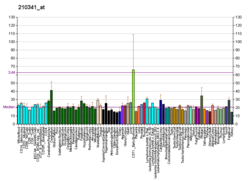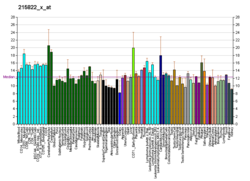MYT1
 From Wikipedia the free encyclopedia
From Wikipedia the free encyclopedia
Myelin transcription factor 1 is a protein that in humans is encoded by the MYT1 gene.[5][6][7]
Function[edit]
The protein encoded by this gene is a member of a family of neural specific, zinc finger-containing DNA-binding proteins. The protein binds to the promoter regions of proteolipid proteins of the central nervous system and plays a role in the developing nervous system.[7]
Interactive pathway map[edit]
Click on genes, proteins and metabolites below to visit related articles. [§ 1]
Interactions[edit]
MYT1 has been shown to interact with PIN1.[8]
References[edit]
- ^ a b c GRCh38: Ensembl release 89: ENSG00000196132 – Ensembl, May 2017
- ^ a b c GRCm38: Ensembl release 89: ENSMUSG00000010505 – Ensembl, May 2017
- ^ "Human PubMed Reference:". National Center for Biotechnology Information, U.S. National Library of Medicine.
- ^ "Mouse PubMed Reference:". National Center for Biotechnology Information, U.S. National Library of Medicine.
- ^ Kim JG, Hudson LD (December 1992). "Novel member of the zinc finger superfamily: A C2-HC finger that recognizes a glia-specific gene". Molecular and Cellular Biology. 12 (12): 5632–9. doi:10.1128/mcb.12.12.5632. PMC 360502. PMID 1280325.
- ^ Booher RN, Holman PS, Fattaey A (August 1997). "Human Myt1 is a cell cycle-regulated kinase that inhibits Cdc2 but not Cdk2 activity". The Journal of Biological Chemistry. 272 (35): 22300–6. doi:10.1074/jbc.272.35.22300. PMID 9268380.
- ^ a b "Entrez Gene: MYT1 myelin transcription factor 1".
- ^ Wells NJ, Watanabe N, Tokusumi T, Jiang W, Verdecia MA, Hunter T (October 1999). "The C-terminal domain of the Cdc2 inhibitory kinase Myt1 interacts with Cdc2 complexes and is required for inhibition of G(2)/M progression". Journal of Cell Science. 112 (19): 3361–71. doi:10.1242/jcs.112.19.3361. PMID 10504341.
Further reading[edit]
- Gogate N, Verma L, Zhou JM, Milward E, Rusten R, O'Connor M, Kufta C, Kim J, Hudson L, Dubois-Dalcq M (August 1994). "Plasticity in the adult human oligodendrocyte lineage". The Journal of Neuroscience. 14 (8): 4571–87. doi:10.1523/JNEUROSCI.14-08-04571.1994. PMC 6577192. PMID 7519254.
- Armstrong RC, Kim JG, Hudson LD (August 1995). "Expression of myelin transcription factor I (MyTI), a "zinc-finger" DNA-binding protein, in developing oligodendrocytes". Glia. 14 (4): 303–21. doi:10.1002/glia.440140407. PMID 8530187. S2CID 38779689.
- Liu F, Stanton JJ, Wu Z, Piwnica-Worms H (February 1997). "The human Myt1 kinase preferentially phosphorylates Cdc2 on threonine 14 and localizes to the endoplasmic reticulum and Golgi complex". Molecular and Cellular Biology. 17 (2): 571–83. doi:10.1128/mcb.17.2.571. PMC 231782. PMID 9001210.
- Kim JG, Armstrong RC, v Agoston D, Robinsky A, Wiese C, Nagle J, Hudson LD (October 1997). "Myelin transcription factor 1 (Myt1) of the oligodendrocyte lineage, along with a closely related CCHC zinc finger, is expressed in developing neurons in the mammalian central nervous system". Journal of Neuroscience Research. 50 (2): 272–90. doi:10.1002/(SICI)1097-4547(19971015)50:2<272::AID-JNR16>3.0.CO;2-A. PMID 9373037. S2CID 37120295.
- Nagase T, Ishikawa K, Suyama M, Kikuno R, Hirosawa M, Miyajima N, Tanaka A, Kotani H, Nomura N, Ohara O (December 1998). "Prediction of the coding sequences of unidentified human genes. XII. The complete sequences of 100 new cDNA clones from brain which code for large proteins in vitro". DNA Research. 5 (6): 355–64. doi:10.1093/dnares/5.6.355. PMID 10048485.
- Kikuno R, Nagase T, Ishikawa K, Hirosawa M, Miyajima N, Tanaka A, Kotani H, Nomura N, Ohara O (June 1999). "Prediction of the coding sequences of unidentified human genes. XIV. The complete sequences of 100 new cDNA clones from brain which code for large proteins in vitro". DNA Research. 6 (3): 197–205. doi:10.1093/dnares/6.3.197. PMID 10470851.
- Hirayama A, Oka A, Ito M, Tanaka F, Okoshi Y, Takashima S (January 2003). "Myelin transcription factor 1 (MyT1) immunoreactivity in infants with periventricular leukomalacia". Brain Research. Developmental Brain Research. 140 (1): 85–92. doi:10.1016/S0165-3806(02)00585-0. PMID 12524179.
- Nielsen JA, Berndt JA, Hudson LD, Armstrong RC (January 2004). "Myelin transcription factor 1 (Myt1) modulates the proliferation and differentiation of oligodendrocyte lineage cells". Molecular and Cellular Neurosciences. 25 (1): 111–23. doi:10.1016/j.mcn.2003.10.001. PMID 14962745. S2CID 28151272.
- Vana AC, Lucchinetti CF, Le TQ, Armstrong RC (May 2007). "Myelin transcription factor 1 (Myt1) expression in demyelinated lesions of rodent and human CNS". Glia. 55 (7): 687–97. doi:10.1002/glia.20492. PMC 2789289. PMID 17330875.
External links[edit]
- MYT1+protein,+human at the U.S. National Library of Medicine Medical Subject Headings (MeSH)
This article incorporates text from the United States National Library of Medicine, which is in the public domain.






